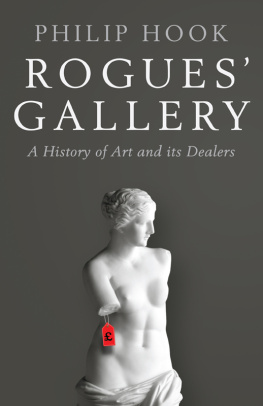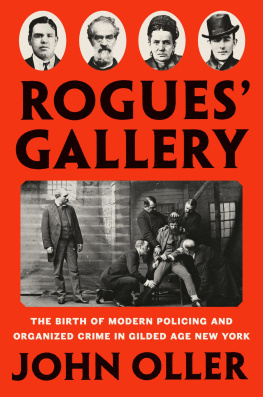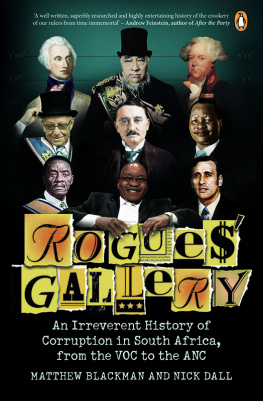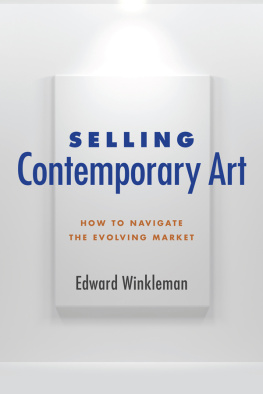Philip Hook - Rogues Gallery: A History of Art and its Dealers
Here you can read online Philip Hook - Rogues Gallery: A History of Art and its Dealers full text of the book (entire story) in english for free. Download pdf and epub, get meaning, cover and reviews about this ebook. year: 2017, publisher: Profile Books, genre: Detective and thriller. Description of the work, (preface) as well as reviews are available. Best literature library LitArk.com created for fans of good reading and offers a wide selection of genres:
Romance novel
Science fiction
Adventure
Detective
Science
History
Home and family
Prose
Art
Politics
Computer
Non-fiction
Religion
Business
Children
Humor
Choose a favorite category and find really read worthwhile books. Enjoy immersion in the world of imagination, feel the emotions of the characters or learn something new for yourself, make an fascinating discovery.
- Book:Rogues Gallery: A History of Art and its Dealers
- Author:
- Publisher:Profile Books
- Genre:
- Year:2017
- Rating:3 / 5
- Favourites:Add to favourites
- Your mark:
- 60
- 1
- 2
- 3
- 4
- 5
Rogues Gallery: A History of Art and its Dealers: summary, description and annotation
We offer to read an annotation, description, summary or preface (depends on what the author of the book "Rogues Gallery: A History of Art and its Dealers" wrote himself). If you haven't found the necessary information about the book — write in the comments, we will try to find it.
Philip Hook: author's other books
Who wrote Rogues Gallery: A History of Art and its Dealers? Find out the surname, the name of the author of the book and a list of all author's works by series.
Rogues Gallery: A History of Art and its Dealers — read online for free the complete book (whole text) full work
Below is the text of the book, divided by pages. System saving the place of the last page read, allows you to conveniently read the book "Rogues Gallery: A History of Art and its Dealers" online for free, without having to search again every time where you left off. Put a bookmark, and you can go to the page where you finished reading at any time.
Font size:
Interval:
Bookmark:
ROGUES
GALLERY
PHILIP HOOK is a Board member and senior director of Impressionist & Modern art at Sothebys in London. He previously worked at Christies in the 19th Century Paintings Department. He has appeared regularly on Antiques Roadshow and is the author of five novels and many books on the art world, including Breakfast at Sothebys (2013) which was a book of the year in the Sunday Times, Spectator, Financial Times, Guardian and Mail on Sunday.
Also by the author
The Ultimate Trophy:
How the Impressionist Painting Conquered the World
Breakfast at Sothebys: An AZ of the Art World
Novels
Optical Illusions
The Stonebreakers
The Island of the Dead
The Soldier in the Wheatfield
An Innocent Eye
ROGUES
GALLERY
A HISTORY OF ART AND ITS DEALERS
PHILIP HOOK

First published in Great Britain in 2017 by
PROFILE BOOKS LTD
3 Holford Yard
Bevin Way
London
WC1X 9HD
www.profilebooks.com
Copyright Philip Hook 2017
The moral right of the author has been asserted.
All rights reserved. Without limiting the rights under copyright reserved above, no part of this publication may be reproduced, stored or introduced into a retrieval system, or transmitted, in any form or by any means (electronic, mechanical, photocopying, recording or otherwise), without the prior written permission of both the copyright owner and the publisher of this book.
A CIP catalogue record for this book is available from the British Library.
eISBN 978 1 78283 215 7
INTRODUCTION
I n the 1920s the legendary dealer Joseph Duveen, alert to all the nuances of selling art, deployed a strategy known as Below-stairs Intelligence. He paid bribes to the servants of his richer clients to elicit useful information about their masters. By this means he discovered that the Baron Maurice de Rothschild, a notoriously autocratic and ill-tempered collector, suffered from chronic constipation. Buying art is a matter not of science but of stomach, so before contemplating any business with him it was advisable to telephone his valet de chambre to see if his bowels had moved that morning. Such attention to detail distinguishes the great art dealers. There is a heroism to their persistence and ingenuity. They can be pioneers, too: A man of action like the conqueror, a man of judgment like the critic, a man of passion like the apostle was the rhapsodical verdict of Arsne Alexandre on the art dealing champion of the Impressionists, Paul Durand-Ruel. Marcel Duchamps view of art dealers, on the other hand, was more succinct: Lice on the backs of the artists. Whether they are conquerors or parasites, or somewhere in-between, the history of art would be very different and much less rich (both literally and metaphorically) without art dealers. Both the pleasure and the hazard of their profession can be traced to the unique nature of the commodity in which they are trading.
Art has very little functional value. I suppose that in the direst emergency a canvas by Roy Lichtenstein could be strung up horizontally on four poles to provide shelter from sun or rain, or a Henry Moore maquette could be used as a doorstop. I have a friend who, with no string to bind the asparagus he was cooking upright in a pan of boiling water, undid the picture wire from the back of a nearby framed work by Bernard Buffet and used that. This was a rare instance of a work of art providing (indirectly) physical as well as spiritual sustenance. But that is not the purpose for which art is sold to a buyer, even a Buffet. No, the value of art lies in less quantifiable realms, governed by concepts like beauty, quality and rarity. That makes it a commodity with a value of disconcerting elasticity, because the criteria that determine it are spiritual, intellectual and aesthetic, often mixed with the social and aspirational. Thus those charged with the sale of works of art dwell in a glorious, free-ranging territory where fantasy is king, and something worth $100,000 in one context can the next day be worth $200,000 in another (or sometimes, more dispiritingly, only $50,000). It depends who is selling it, and how compelling their sales pitch is.
Art dealers are purveyors of fantasy. I dont mean fantasy in the sense of an untruth, but rather the sort of fantasy that stimulates soarings of the imagination, elevations of the spirit, and tantalising glimpses of highly remunerative investment. This is the territory of the art dealer, that Elysian Field bounded at the one end by the price of the work bought and at the other by the price of the work sold (or, to use the modern euphemism, the work sourced and the work placed). The larger the distance between the two, the happier the dealer. Delacroix recognised the element of fantasy that attends every successful sale of a work of art when he described art dealers as financiers du mystre. We all create myths about ourselves. Art dealers are particularly good at it, purveying as they do a compelling brand of fantasy in a market that is passionate rather than rational. Fantasy is infectious, too: sometimes it seeps through from the object sold to the seller himself, who starts to believe his own myth. Indeed some of the most successful art dealers have been those most firmly convinced of their own wonderfulness.
Art dealing is about persuading people to buy things they want but dont need. That, of course, is the challenge confronting the entire luxury goods industry. But what sets art apart is that you are marketing something beyond mere skill; you are marketing something intangible, unmeasurable, but infinitely desirable: genius. It is the mystery ingredient, inherent in the perception of art from the Renaissance onwards, but first identified and deployed in a big way by the Romantic movement. And it is no coincidence that the period when art starts being most boldly perceived as a matter of genius, in the nineteenth century, is the moment when art dealers start to flourish most significantly. Because genius is that gloriously unquantifiable value-adder.
The price of a work of art is an index of pure, irrational desire, wrote Robert Hughes, and nothing is more manipulable than desire. The buyer of the superb Czanne Garon au gilet rouge, which made a record-breaking price in the Goldschmidt sale at Sothebys in 1958, was revealed to be the great American collector Paul Mellon. To the question of whether he had paid too much his answer was emphatic: You stand in front of a picture like that, and what is money? What indeed? Great art was being acknowledged as, literally, beyond price. It is an extension of the devotional metaphor. Art, for twenty-first-century society, is the new religion. Buying art is like religious belief: it involves an act of faith. Trying to rationalise that process by a clinical analysis of the sum paid for a great work of art is as futile as the application of scientific reason to transcendent religious experience. It is, as Paul Mellon declares, irrelevant. That irrelevance, vouched for by a major and respected player in the top league of world wealth, was a glorious justification for art dealers to set their own prices for the best works. As the art-market historian Gerald Reitlinger observed, the value placed on pure genius is limited only by the fluid capital available. You stand in front of a picture like that, and what is money?: it is a quotation that Sothebys and Christies might print next to any masterpiece they offer in their catalogues, in lieu of a pre-sale estimate.
The history of art dealing is different from the history of the art market. The key to art dealing, and to the history of its most significant exponents, is the personality of the art dealer. That is the theme of this book, a study of the fascinating band of men (and women) who devoted their imagination, ingenuity and powers of persuasion to selling works of art. The history of art dealing is also distinct from the history of collecting, but you cannot study the former without some awareness of the latter. Collectors are the clients of art dealers. You cannot understand the challenges that confront art dealers, and the methods they have devised to meet them, without understanding something of the motivations of the people to whom they purvey art. There are collectors primarily driven by investment, and collectors whose priority is intellectual and aesthetic. There is a similar scale that defines art dealers: at one end you have the merchant, in it for the money, and at the other end the scholar who wouldnt soil his hands with commerce at all if he didnt need to finance his own collection. All art dealers take their place somewhere along that line. Then there is the distinction between the dealer who handles old art (by dead artists) and the one who handles and promotes living artists. It is the distinction between a Duveen and a Kahnweiler or a Castelli.
Next pageFont size:
Interval:
Bookmark:
Similar books «Rogues Gallery: A History of Art and its Dealers»
Look at similar books to Rogues Gallery: A History of Art and its Dealers. We have selected literature similar in name and meaning in the hope of providing readers with more options to find new, interesting, not yet read works.
Discussion, reviews of the book Rogues Gallery: A History of Art and its Dealers and just readers' own opinions. Leave your comments, write what you think about the work, its meaning or the main characters. Specify what exactly you liked and what you didn't like, and why you think so.






